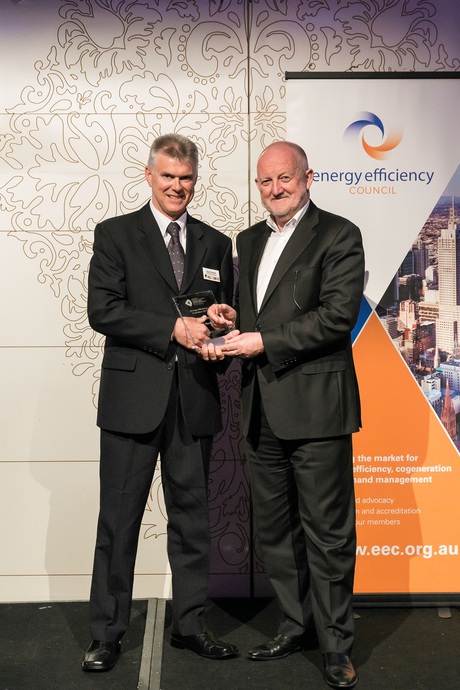National Energy Efficiency Conference highlights

The National Energy Efficiency Conference, held this week in Melbourne by the Energy Efficiency Council (EEC), enabled over 300 efficiency leaders, innovators, energy users and policymakers to come together to hear, debate and analyse the latest Australian and global thinking about maximising productivity by saving energy.
National Energy Efficiency Industry Awards
The conference saw the presentation of the National Energy Efficiency Industry Awards, delivered to a diverse range of businesses and governments for outstanding achievements in energy efficiency in commercial buildings, industry, SME, residential and demand response projects.
Award winners included:
- Best SME Energy Efficiency Project 2015: Ryan Meat Company and Minus40
- Best Residential Energy Efficiency Project 2015: CitySmart, for Reduce Your Juice
- Best Energy Savings Program 2015: Moreland Energy Foundation, for achievements from 2000–2015
- Best Demand Response Project 2015: Australian Textile Mills and EnerNOC, for Technology-Enabled Critical Peak Demand Response
- Best Industrial Energy Efficiency Project 2015: Tri-Tech Chemical and Genesis Now
- Best Commercial Building Energy Efficiency Project 2015: Mirvac Property Trust, for Sirius
- Leading Energy User 2015: Charter Hall Group, for energy efficiency in the Charter Hall Office Trust
- Energy Efficiency Champion 2015: Stuart Nesbitt, climate change technical officer at Moreland City Council
“Tonight’s winners represent the best efficiency projects in Australia and, importantly, the outstanding efficiency providers and the visionary clients who make them happen,” said EEC CEO Luke Menzel. “Their expertise, skill and commitment are helping Australia reduce its energy use across the board.”
Retrofit survey results
Conference attendees also heard the results of the Melbourne Retrofit Survey 2015, which collects data from building owners, building managers and facilities managers on retrofit activity undertaken in commercial buildings. The survey found that 37% of commercial buildings in central Melbourne have retrofitted to improve their environmental performance in the last five years.
Key findings from the survey include:
- 37%, or 541 commercial buildings in the municipality, have retrofitted since 2010.
- 21%, or 315 buildings, intend to retrofit within the next five years.
- 12% of buildings spent over $1 million.
- 92% of retrofits included a lighting upgrade, 49% involved a chiller upgrade and 20% included an upgrade to the building management system.
- Retrofit activity is on the rise, with 11% of buildings in 2015 ‘currently’ being retrofitted (compared to 7% in 2011 and 5% in 2013).
Environment Portfolio Chair Councillor Arron Wood said retrofitting to improve a building’s performance “makes economic sense”, since more efficient buildings “cost less to run and are more likely to attract and retain tenants”.
“There is a clear business case for these retrofits in terms of improved air quality, temperature quality and staff attraction and retention,” he said.
The survey results can be downloaded from the City of Melbourne website.
A new pathway for mid-tier commercial office buildings
Finally, the Green Building Council of Australia (GBCA) launched a new document to tackle the energy productivity of up to 80,000 buildings mid-tier commercial office buildings around Australia.
The report ‘Mid-tier commercial office buildings in Australia: a national pathway to improving energy productivity’ takes a snapshot of the nation’s mid-tier office building sector, outlines key stakeholders and identifies barriers and the opportunities to improve energy efficiency. Mid-tier buildings are commonly defined as B-, C- and D-grade buildings, usually found in capital city CBDs and fringe areas, suburban centres and some regional towns.
The pathway document includes the following actions:
- A Building Retrofit Toolkit, which will establish best practice in retrofits and tune-ups in mid-tier buildings.
- Reviewing the scope of the current Commercial Buildings Disclosure program to encompass smaller office buildings.
- Building a business case for energy-efficiency upgrades.
- Conducting further research to better understand the sector and its stakeholders.
- Establishing a sector network to increase collaboration, innovation and exchange.
“The mid-tier office sector presents huge opportunities,” said GBCA Director of Advocacy Katy Dean, “and our industry can be an exemplar for energy efficiency and greenhouse gas emissions reduction around the world.”
The report can be downloaded from the GBCA website.
Berrima Cement Works upgrades with sustainable tech
Boral has unveiled new carbon-reducing technology at the site, which supplies 40% of cement in...
Australian orgs partner to speed circular economy
GS1 Australia has joined forces with the Product Stewardship Centre of Excellence to drive the...
Victorian utility recognised at Asian Water Awards
South East Water won two awards for its Hydrotrak Geofencing technology, which has helped it to...







